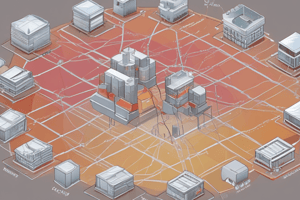Podcast
Questions and Answers
What is the primary factor considered by routers when making routing decisions?
What is the primary factor considered by routers when making routing decisions?
- Destination MAC address
- Destination IP address
- Source IP address
- Network topology and administrative distance (correct)
Which type of switching is characterized by the storage of the entire frame in the switch's buffer before forwarding?
Which type of switching is characterized by the storage of the entire frame in the switch's buffer before forwarding?
- Packet switching
- Store-and-forward switching (correct)
- Cut-through switching
- Fragment-free switching
What is the final step in the packet forwarding process?
What is the final step in the packet forwarding process?
- Transmission to next hop (correct)
- Packet rewriting
- Decapsulation
- Routing decision
What is the purpose of the EtherType field in the frame format?
What is the purpose of the EtherType field in the frame format?
What is the primary function of a routing table in a router?
What is the primary function of a routing table in a router?
Which layer of the OSI model does a switch operate at, although it can also perform some functions of another layer?
Which layer of the OSI model does a switch operate at, although it can also perform some functions of another layer?
Study Notes
Networking Layer (OSI Layer 3)
Routing
- Process of determining the best path for forwarding packets between networks
- Routers use routing tables to store information about network topology
- Routing protocols (e.g. RIP, OSPF, BGP) are used to update routing tables
- Routing decisions are based on factors such as:
- Destination IP address
- Network topology
- Traffic congestion
- Administrative distance
Switching
- Process of forwarding packets between networks based on MAC addresses
- Switches operate at Layer 2 (Data Link Layer) but can also perform some Layer 3 functions
- Types of switching:
- Store-and-forward switching
- Cut-through switching
- Fragment-free switching
Packet Forwarding
- Process of sending packets from one interface to another
- Routers use routing tables to determine the next hop for packet forwarding
- Packet forwarding involves:
- Decapsulation (removing headers)
- Routing decision
- Encapsulation (adding headers)
- Transmission to next hop
Frame Format
- A packet at the networking layer is encapsulated in a frame at the data link layer
- Frame format consists of:
- Preamble (optional)
- Destination MAC address
- Source MAC address
- EtherType (protocol identifier)
- Packet payload (packet at networking layer)
- Frame Check Sequence (FCS) for error detection
Networking Layer (OSI Layer 3)
Routing
- Determines the best path for forwarding packets between networks
- Uses routing tables to store network topology information
- Deploys routing protocols (RIP, OSPF, BGP) to update routing tables
- Routing decisions based on:
- Destination IP address
- Network topology
- Traffic congestion
- Administrative distance
Switching
- Forwards packets between networks based on MAC addresses
- Operates at Layer 2 (Data Link Layer) with some Layer 3 functions
- Types of switching:
- Store-and-forward switching
- Cut-through switching
- Fragment-free switching
Packet Forwarding
- Sends packets from one interface to another
- Uses routing tables to determine the next hop
- Involves:
- Decapsulation (removing headers)
- Routing decision
- Encapsulation (adding headers)
- Transmission to next hop
Frame Format
- A packet at the networking layer is encapsulated in a frame at the data link layer
- Frame format consists of:
- Preamble (optional)
- Destination MAC address
- Source MAC address
- EtherType (protocol identifier)
- Packet payload (packet at networking layer)
- Frame Check Sequence (FCS) for error detection
Studying That Suits You
Use AI to generate personalized quizzes and flashcards to suit your learning preferences.
Description
Explore the concepts of routing and switching in the Networking Layer of the OSI model, including routing tables, protocols, and decision factors.




